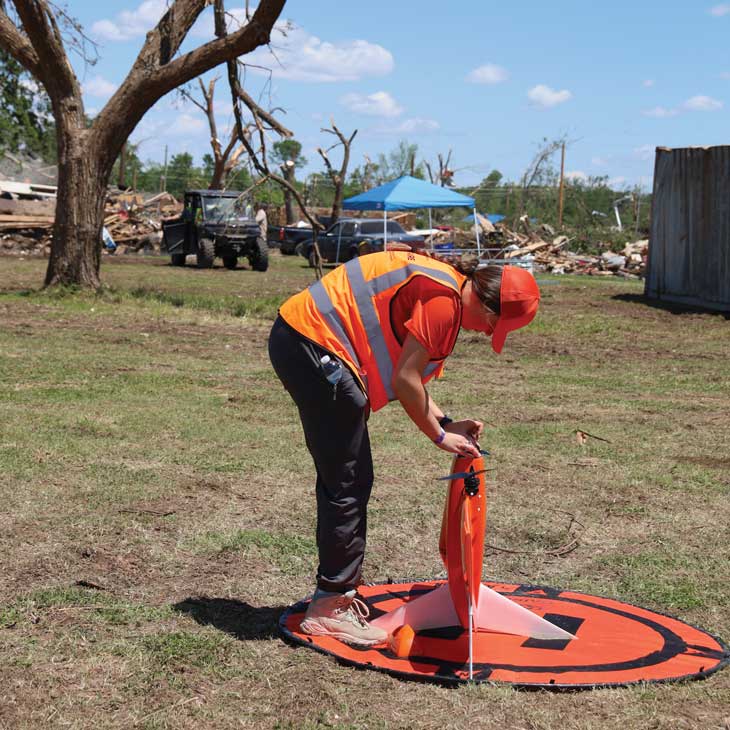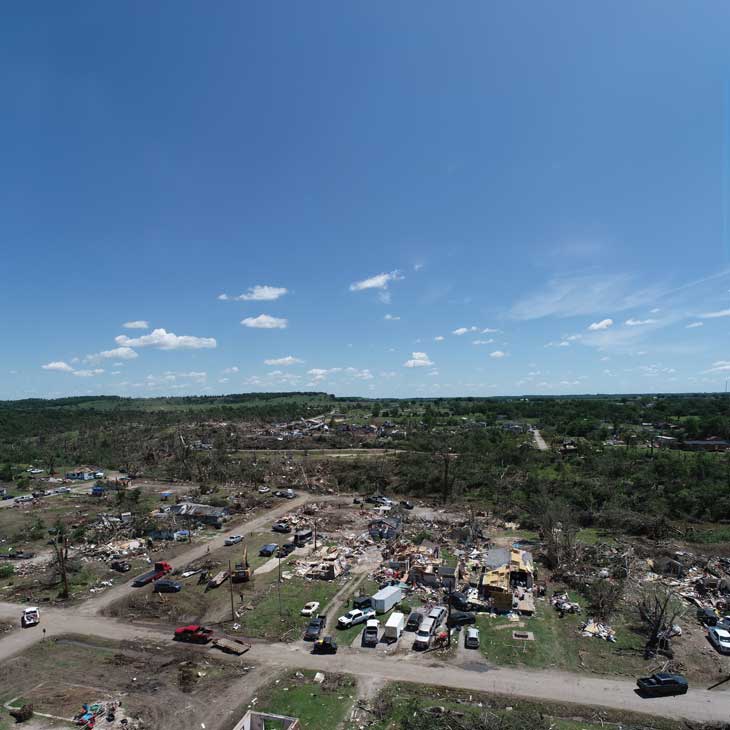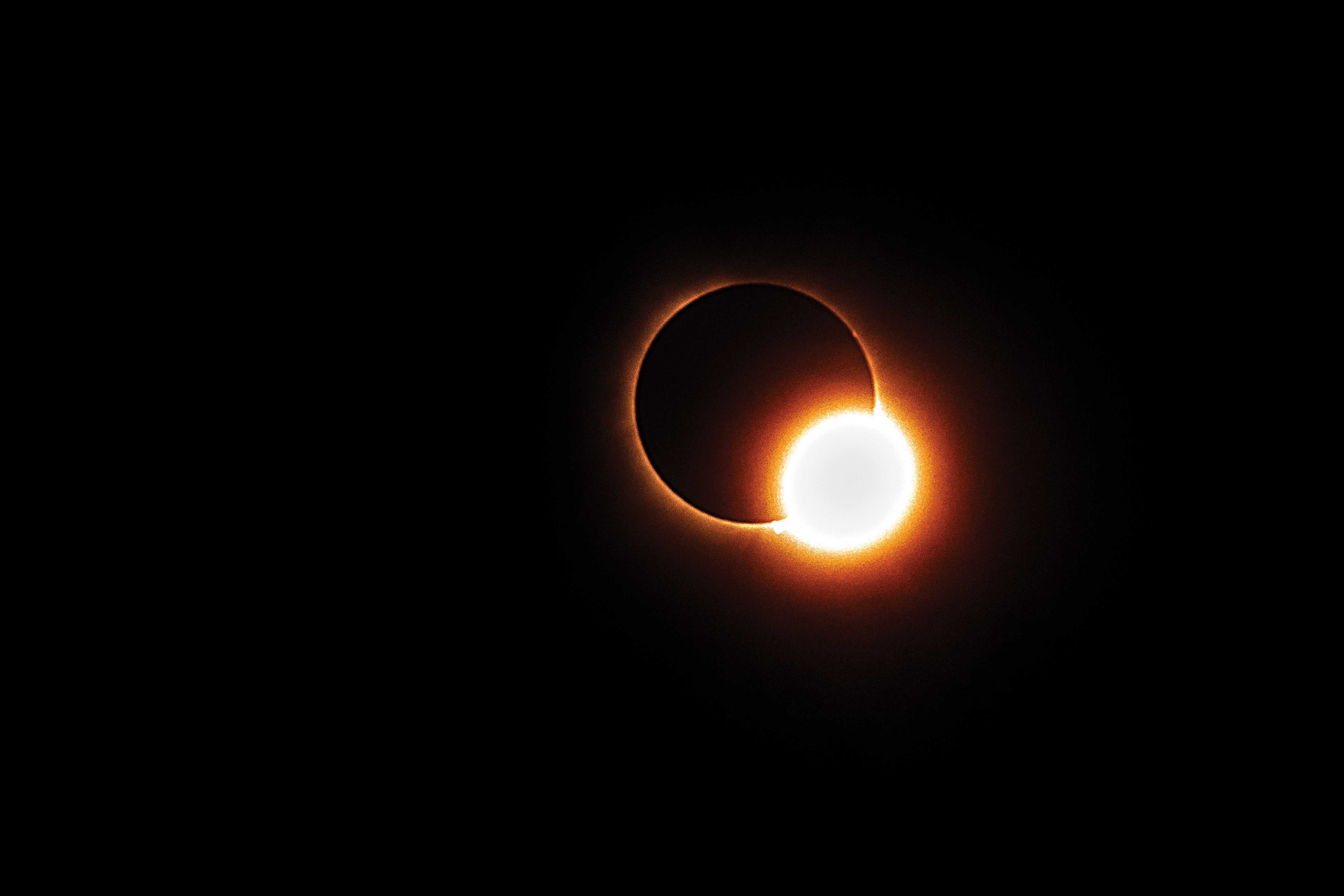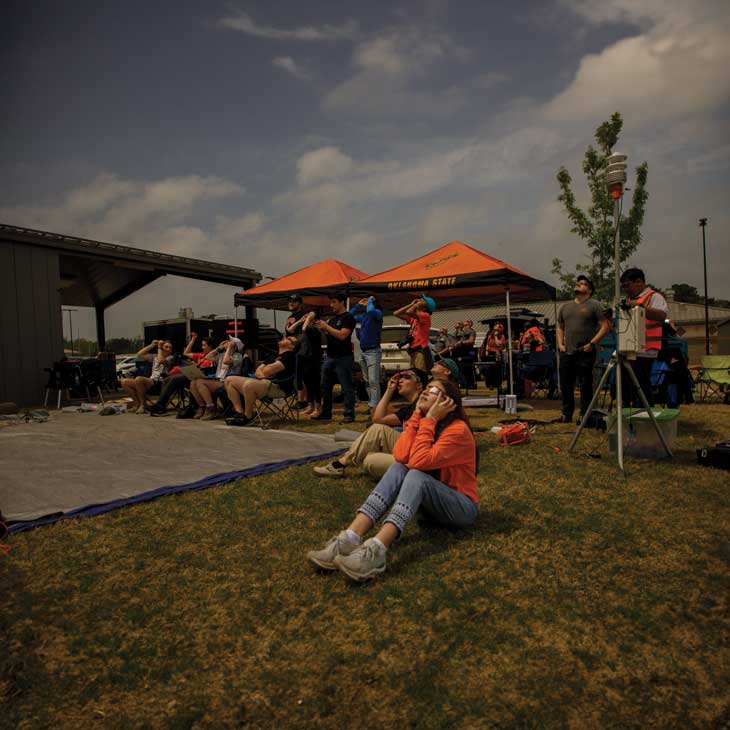
Help from Above: OAIRE conducts groundbreaking research in numerous weather-related areas
Friday, September 13, 2024
Media Contact: Mack Burke | Associate Director of Media Relations | 405-744-5540 | editor@okstate.edu
"Nature is so powerful, so strong. Capturing its essence is not easy — your work becomes a dance with light and the weather."
Weather’s unpredictability can change seasons in an instant and turn a bright, sunny day into a tumultuous, confounding chaos with little to no warning.
A team at the Oklahoma Aerospace Institute for Research and Education hopes its research in numerous areas dedicated to observing, predicting and assessing weather-related phenomena might influence the future of meteorology.
From research to Extension, from weather damage assessment to gravity wave generation, OAIRE continues to fulfill its land-grant mission from the skies.
Assessing the aftermath
The sound of a runaway locomotive barreling out of control toward you.
That’s how some have described the aura of a tornado, and the aftermath can be shocking.
A recent partnership with faculty in the School of Civil and Environmental Engineering and the National Weather Service office in Tulsa has allowed engineers from OAIRE to lend aerial assistance in identifying and assessing a tornado’s path of destruction.
“Like the sound of a tree falling in the woods, a tornado doesn’t truly exist unless it is seen by an eyewitness or there is sufficient damage to suggest that a tornado touched down,” said Dr. Jamey Jacob, OAIRE executive director and professor and John Hendrix chair in the School of Mechanical and Aerospace Engineering. “For that reason, the damage assessments conducted by individuals from emergency management teams and National Weather Service personnel after the fact are crucial to understanding the characteristics of a probable tornado.”

Once a tornado occurs and there is confirmed damage — in the two Oklahoma towns of Barnsdall and Claremore for instance — a team of pilots and engineers from OAIRE deploy to the site to provide aerial coverage.
The team uses a VTOL fixed-wing uncrewed aircraft system, or UAS, to rapidly assess an area to determine the direction and length of the damage path, which it uses to plot a course for a fixed-wing aircraft called a Wingtra. The Wingtra is generally used for agricultural or surveying purposes, which is a simplified version of what the OAIRE team is conducting during flights. The UAS allows the team to cover more area rapidly and boasts an extended flight time compared to other aerial systems.
The UAS will autonomously traverse its preprogrammed flight path in a “lawn-mower type path” at an altitude of nearly 400 feet while taking highly detailed photographs of the area at predetermined intervals.
“The flight process is fairly simple,” said Emalee Hough, a research and development engineer at OAIRE. “Once we program the flight path, we become observers that watch out for possible points of interference such as other aircraft. The ‘harder’ part is when the flight is done and we sometimes have thousands of photos to process.”
After the assessment is completed, each photo is geotagged with info and uploaded into a 3D rendering software, which stitches together each photo pixel to provide as accurate a 3D model as possible.
These renderings are then disseminated to other researchers and weather personnel to provide a more accurate and detailed assessment of the damage, path, longevity and other characteristics of a supposed tornado.
The CIVE faculty researchers hope that examining the destruction caused by a tornado, specifically to structures, may provide insight into how to construct more robust buildings and infrastructure able to better withstand a tornado’s destructive forces.
“Assessment of the damage to civil structures after natural hazard events such as tornadoes is critical for emergency response operations and mitigation of the risks of future events,” said Dr. Maha Kenawy, assistant professor with CIVE. “Rapidly evolving unmanned aerial technologies and emerging data-driven approaches have created unique opportunities for advancing post-disaster damage assessment of civil structures.
“Our research team will integrate physics-based and data-driven modeling techniques to improve and accelerate the processing and interpretation of civil infrastructure damage data collected by unmanned aircraft systems. This work will also help identify infrastructure vulnerabilities that can be addressed to increase the resilience of communities across the U.S. against intense tornado events.”

For weather researchers, these aerial assessments provide a faster, more precise representation of the destructive path of a tornado, which may help to better understand the characteristics and behaviors of these seemingly unpredictable storms.
“This really is an extension of our land-grant mission,” Jacob said. “To help our communities assess and better understand these weather phenomena will hopefully lead to developments that can mitigate the impact they have on our citizens. In the not-too-distant future, I foresee emergency management teams, utility companies and weather researchers alike implementing assessment systems like these to further enhance response times and impact research.”
Until that vision becomes a reality, the OAIRE team is ready to lend its expertise to help individuals and communities affected by these powerful storms.
“It’s a humbling and amazing experience to be a part of this project,” said Allan Burba, an OAIRE flight crew member. “It’s hard to grasp the destructive forces of these storms and the devastation they can cause until you see it up close and personal. Being a part of research that may someday lessen the impact a tornado can cause is amazing.”
As a native Oklahoman, Hough has a unique connection to severe weather and the unpredictability of tornadoes.
“I grew up watching these storms and being terrified of them,” Hough said. “Barnsdall was the first tornado damage I’ve seen up close, and to be able to help my neighbors and their communities and progress the science and research into these storms is really important to me.”
Science in the shade
The recent solar eclipse provided an amazing viewing experience for astronomy enthusiasts and hobbyists alike. For OAIRE engineers, it was an opportunity to conduct unique research “in the shade.”
Sixteen OSU students and faculty members were joined by NASA representatives at the Choctaw Nation Community Center in Broken Bow, Oklahoma, where they conducted research as part of the NASA National Eclipse Balloon Program.
The team launched balloons to gather atmospheric data for nearly 36 hours surrounding the eclipse.
Jacob likened the eclipse’s effect to that of a pebble in a pond.

The team launched balloons to gather atmospheric data for nearly 36 hours surrounding the eclipse.
Jacob likened the eclipse’s effect to that of a pebble in a pond.
“Just like a pebble causes waves in the water, the eclipse causes gravity waves in its wake as it moves across the Earth, and we wanted to measure those disturbances,” he said. “These waves are essential for transporting energy in the atmosphere. They’re good at mixing the air and act as conveyor belts to help move energy and moisture from one location to another just like waves in the ocean.”
Jacob said the goal was to take the atmospheric readings from such a rare but known event and use it to provide general improvements to numerical weather prediction models.
“The atmosphere is so complicated to model — it’s just a very complex phenomena,” he said. “The eclipse provided a way to verify existing models using a known condition.”
OSU was one of 50 teams across the U.S. to participate in the NASA program, with OSU serving as an atmospheric science pod lead.
“We were responsible for organizing and supporting other teams leading up to the eclipse and bringing their data together post-event. We had teams spread out between Texas, Oklahoma and Arkansas,” Jacob said.
The OAIRE team also had a distinction from others compiling data; Dr. Brian Elbing, renowned OSU tornado researcher, incorporated infrasonic arrays into the data collection arsenal to better understand how those systems work for tornado detection.
“The solar eclipse can generate gravity waves within the atmosphere and these induce pressure fluctuations within the atmosphere,” Elbing said. “The pressure changes occur over long periods of time and can be detected as very low frequency sound known as infrasound.”
As a Choctaw citizen and planetary scientist, this event has special meaning to OSU Aviation and Space assistant professor Dr. Kat Gardner-Vandy, who used the event to help achieve goals for her NASA Science Activation project, Native Earth | Native Sky (NENS).
“Seeing the eclipse from Choctaw Nation was truly remarkable,” Gardner-Vandy said. “Through NENS, we co-created curriculum with the Choctaw Nation about the story of Tvskha and Walo, two young boys who left their home on foot to find where the Sun died each night. They eventually made it to the Sun and talked to him and his wife, the Moon. Including this story in our science curriculum and then experiencing the solar eclipse with other Choctaw citizens demonstrates the beautiful interweaving of Native stories and science. Talking about our curriculum, passing out eclipse glasses and seeing Choctaw youth help launch balloons with OAIRE were huge highlights of the day.”
OAIRE also took drones to serve as a repeatable system taking the same measurements. Jacob said someday the balloons that carry the instruments will be replaced by drone fleets.
Zach Yap, a research and development engineer with OAIRE, has been conducting research with OSU for years, including as an undergraduate and graduate student.

“This was a wonderful opportunity to see what happens when you essentially turn off the sun and have a rapid onset of darkness,” he said. “An eclipse is an interesting and unique way of generating atmospheric gravity waves. They happen between different layers in the atmosphere, and the waves are good movers of energy for storms and other things. If we can better understand how these waves propagate through the atmosphere, we can better — on a continental scale — forecast weather systems.”
In addition to OSU leading several other universities, OAIRE researchers had the opportunity to be a resource for students at Gordon Cooper Technology Center in Shawnee, Oklahoma, and high schools in Okmulgee, Oklahoma.
“Through the NEPB and OSU, we can give them the opportunity and resources to learn from these opportunities,” Yap said. “By doing this, we can share this knowledge and inspire them to pursue a STEM career.”
Freshman Research Scholar Lily Yates from Sapulpa, Oklahoma, was part of the OAIRE research team assisting with balloon launches. Conducting weather research is her career and life goal.
“My experience with research at OSU has been absolutely amazing,” she said.
Jacob said the effort included the whole range of student involvement.
“On the science side, we had high school, undergraduate and graduate students working together, and while at the eclipse, we used the opportunity for science outreach for younger kids and to our tribal partners,” he said. “The eclipse itself is a cosmic marvel that inspires awe in all who see it. What better way to reach the next generation of scientists and engineers?”
Photos by: Ray Lucas and OAIRE
Story by: Jeff Hopper and Shannon Rigsby | STATE Magazine
